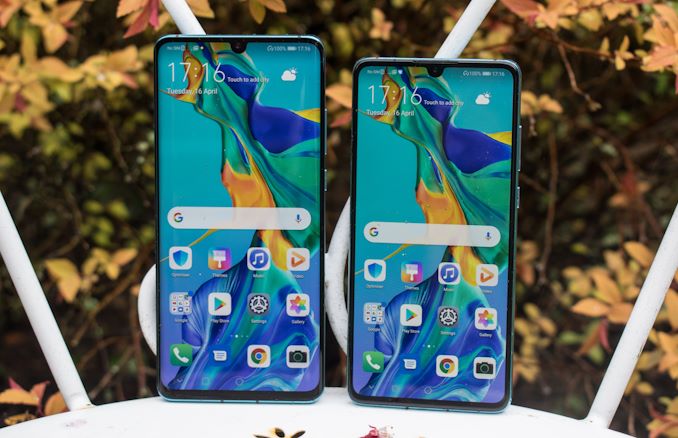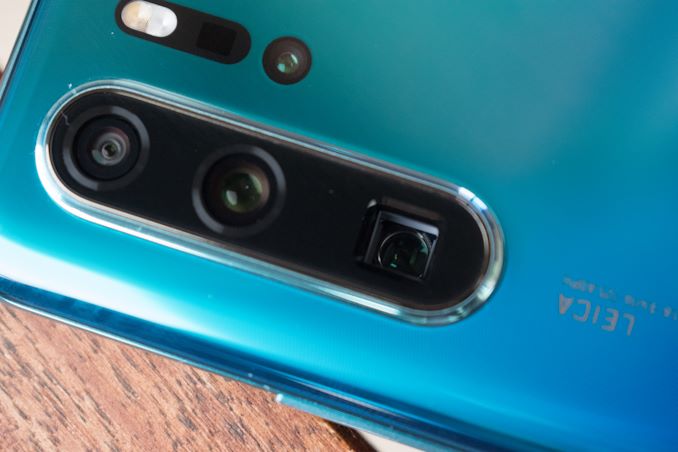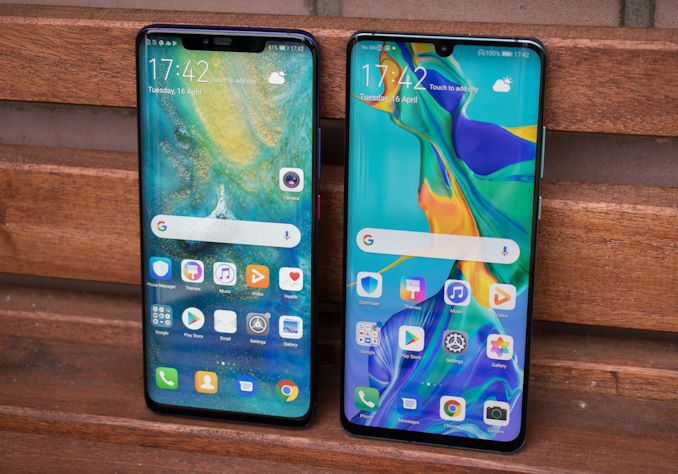The Huawei P30 & P30 Pro Reviews: Photography Enhanced
by Andrei Frumusanu on April 18, 2019 9:00 AM EST- Posted in
- Mobile
- Smartphones
- Huawei
- P30
- P30 Pro
Conclusion & End Remarks
In many ways, the P30 Pro and P30 are both iterative phones. Both devices are taking aspects first introduced in their predecessor P20 series – as well as the sister Mate 20 series – and improving and packaging them into phones with an emphasis on photography.
Design wise, the smaller P30 doesn’t differ all that much from the P20, keeping the same form-factor and also a similar design. Build quality has improved, and the device looks a more premium than its predecessor, mostly due to industrial design changes such the removal of the plastic rim between the body frame and the back glass panel.
Huawei’s choice to go with flat top and bottom frames is quite odd, and it gives the phones a more industrial look and feel than what we’ve become accustomed with compared to the more traditional rounded slab designs.
The bigger P30 Pro adopts the ergonomics of the Mate 20 Pro, meaning it has a curved and flowing display and back cover glass design. I find this design quite fantastic in terms of in-hand feel as well as ergonomics, and it makes the P30 Pro feel like much smaller phone than it actually is. One negative of the new ergonomics is the weight of the phone: at 192g the P30 Pro is a lot heavier than competing devices of its size.
The displays on both P30s are good. Particularly the move to an OLED augments the smaller P30 compared to its predecessor, the LCD-based P20. Huawei was able to seemingly avoid any display issues this time around, as opposed to the concerns of the LG panel units on the Mate 20 Pro. Colour calibration on both phones is good, albeit not excellent. Huawei has achieved better in past models, but it’s not a deal-breaker for the P30s. The only negative about the screens is that I really wish Huawei would have gone 1440p on the P30 Pro – there really is not technical excuse not to adopt it, and it’s just a matter of implementing it correctly.
The dew-drop display notches on the phones are minimal and not intrusive, and I find them better alternatives than what Samsung went with this year.
An odd difference between the two phones is that the P30 has an earpiece speaker while the bigger P30 Pro goes with a piezoelectric under-screen actuator. The problem here is that I just do not see the advantage of these new designs; the earpiece on the P30 is barely visible and sounds better. Unlike Samsung and LG’s recent models, neither of the P30s have stereo playback, and thus lag behind significantly in terms of speaker playback quality. To top off the audio concerns, Huawei continues the senseless design choice of skipping a headphone jack on larger and more expensive P30 Pro while including it on the smaller model..
Both phones have optical under-screen fingerprint sensors, and they’re excellent. The implementation is as good as OnePlus’s, and it’s a much faster sensor than Samsung’s ultrasonic units in the Galaxy S10 series.
The performance of the P30s is excellent thanks to the Kirin 980 SoC. We’ve covered this in past Kirin 980 devices and the new SoC is able to keep up with Qualcomm’s and Samsung’s best for this generation. GPU performance lags a bit behind the flagship competition, but it’s not too bad as it ties in with Snapdragon 845 devices.
Battery life for both phones is excellent, although no longer quite as class-leading, as this title remains with the Mate 20 as well as the new Galaxy S10+.
Cameras Differentiate the P30s
The main selling point of the P-series are supposed to be their cameras, and here Huawei did make some large and interesting changes.
First of all, both P30s now add the wide-angle sensors which were introduced in the Mate 20 series. The additions are fantastic to the shooting experience and Huawei is able to deliver very high quality results, with the P30 Pro having an advantage in quality due to its better sensor.
The zoom optics on the P30 remained the same as what we’ve found on the P20 Pro and Mate 20 Pro – it’s excellent and is able to achieve a higher optical zoom factor than competing devices. Due to the main sensor being 40MP, capturing digitally zoomed in/cropped shots at 2x factor while in 10MP results in little to no quality loss, with the 3x module picking up the slack for further away objects.
While the 5x telephoto module on the P30 Pro is technically impressive in just how far it’s able to go, I’m not very convinced that it’s actually all that beneficial to the everyday capture experience. In particular the device fails to properly bridge the gap between a ~2x and 5x zoom factor, where you’re left with deteriorating image quality and purely digital zooming on the main camera sensor. I honestly do not think that this is how most people use their phones, and I think the 3x zoom on the P30 and previous Huawei devices was a better alternative for the capture experience and most scenarios.
The main camera sensor on the P30s is also interesting. In daylight shots, there are some clear compromises in the new modules. The optics just aren’t as good as what's found on the Mate 20 Pro, and both units suffer from more chromatic aberrations on the outer edges of the images, something that’s immediately visible in the native 40MP capture modes. This issue affects the P30 Pro more than the P30 due to its wider aperture.
Also visible in daylight shots is that detail preservation isn’t as good as the Mate 20 Pro. Besides the optics, this might be caused by the new RYYB sensor which might not have as good pixel isolation as the previous generation sensor.
Daylight processing has changed when compared to the Mate 20 Pro, and while in most cases it’s better, in some cases it also saw regressions. The problem for Huawei is that there’s too large a difference in the processing and resulting images between the different modules. Again I feel as if Huawei putting the responsibility of achieving the best result to the user instead of delivering the best results out of the box. The phones are incredibly versatile in their cameras, but this is also their downfall as they lack consistency.
In low-light scenarios, the P30s are both absolute winners. The new sensor, and particularly the new optics with OIS on the P30 Pro, raise the bar yet again in terms of what one can expect out of a smartphone camera. Huawei’s real only competition here is Google’s Night Sight mode, however once it gets dark enough even the Pixel phones cannot compete with then new Huawei hardware. Compared to other vendors, it’s a completely different league.
Lastly, there’s the question of if the P30 phones are worth their money. Unfortunately I think Huawei’s yet again coming in a little too high on pricing. I have a hard time justifying the P30 Pro’s 999€ price point. The issue here is not only the competition, but also the question of whether this actually represents a better value than say the company’s own Mate 20 Pro, which can now be had for 699€. While impressive, I do not see the 5x telephoto lens as a selling point for the P30 Pro. This leaves the much better low-light capture as the only substantial benefit, as otherwise the P30 Pro represents a downgrade in speaker and display quality, with possibly slightly better battery life.
The P30’s 749€ price seems more reasonable, however again the Galaxy S10 is just 50€ more today, and you’re trading in the excellent low-light capture for an overall better phone.
I think both P30 phones are good devices, however it might be worth to wait a couple of months for the inevitable price drop, as the phones don’t tick all the boxes to be able to justify their launch MSRPs.














85 Comments
View All Comments
jabber - Thursday, April 18, 2019 - link
I have to remind myself...these are phones?StrangerGuy - Thursday, April 18, 2019 - link
Gotta really see the reaction from the DSLR diehards on this one.philehidiot - Thursday, April 18, 2019 - link
I don't understand. DSLR photography is a totally different ballgame to mobile phone photography. I'd say phones like this make compact cameras almost totally irrelevant.DSLR photography is a different kettle of fish - can you even alter the aperture on these phones? Now if you're buying a DSLR for casual photography and never plan to change from the kit lens and just keep it on auto, then yeh... these phones are kind of a kick in the teeth. To those of us for whom using a DSLR is an art and we have insane macro lenses, tripods and occasionally attach them to a telescope.... a good DSLR is going nowhere.
Also, the qualitative beauty of the dynamic range of a DSLR is something subtle and can make or break a photo. Phones tend to go for brash, impactful but ultimately flat photos. You go "wow" when you see them but you can't compare them to the subtle beauty created by a DSLR sensor when used properly by someone who actually cares to do more than point and shoot.
emn13 - Thursday, April 18, 2019 - link
DSLR's are almost certainly dead in the medium to near term, even for professional use. What I *really* can't wait for is the kind of imaging that's going to possible once this kind of advanced processing is *combined* with higher-end optical systems, as should be possible even on compacts and mirrorless systems. Full-frame is all hyped up and stuff, but the optical sweet spot is almost certainly smaller; the kind of apertures possible even on aps-C and 1-inch sensors are quite sufficient for almost impractically small depth of field; and really, that's optically the *only* advantage there is (at least - assuming people would bother to sell high-end lenses for smaller sensors, which they currently do not).I mean, can you imagine something like this on even just an rx-100 style body? Ideally available in versions with zoom or prime? It would be completely bonkers, and portability isn't that much worse than a modern smartphone.
Frenetic Pony - Thursday, April 18, 2019 - link
Ahh, the usual internet "experts". The hilarious part is even thinking SLR's are somehow cutting edge, which shows how behind everyone here is. Every camera company now has a mirrorless version, which actually different as it's not an SLR at all, for one!I'm just a casual, hobbyist photographer. But my older, APSC mirrorless camera absolutely CRUSHES my Galaxy s8 in terms of image quality, even with the custom Pixel camera APK installed. And I want a newer camera as I'm severely limited in dynamic range, lowlight image quality, and what resolution I can get good images at (4k just isn't doable). Not to mention my image edges are still soft even with a nice prime lens.
Maybe in a few years, when those smartphone and "Light" partnerships show up, and they pair up like 5 cameras into one image successfully, then big sensor mirrorless cameras time will be limited. But for now, there's no contest.
philehidiot - Thursday, April 18, 2019 - link
How arrogant. So we are using DSLR as a descriptor for brevity and you decide to use that as some way of proving we are all wrong. No, there just isn't a handy accronym for mirrorless big ass camera with interchangeable lenses. You know perfectly well what we were discussing so why not add to that discussion rather than being picky for the sake of it? And yes, a decent large sensor will, in the right hands, destroy a phone but they are different propositions.tuxRoller - Friday, April 19, 2019 - link
https://petapixel.com/2018/03/14/death-dslrs-near/s.yu - Friday, April 19, 2019 - link
I advise you to stop reading Petapixel, those people are more amateur than GSMArena (who do a pretty good job despite the name) and Androidauthority (who are real amateurs) when it comes to image quality review so I don't know if they're actually qualified.jabber - Friday, April 19, 2019 - link
I think I've been reading 'the death of DSLRs' for at least 12 years. If it is a death its a very loooooong one.zodiacfml - Monday, April 22, 2019 - link
No. emn13 knows what he's talking about. I'm I die hard RAW shooter of APSC cameras but high end smartphones definitely comes close considering the size, features, and cost. I did not expect smartphones to come this close so soon as I always believed size is everthing in image quality.Limited to a 4k display, it is really close to an APSC camera with a kit lens.